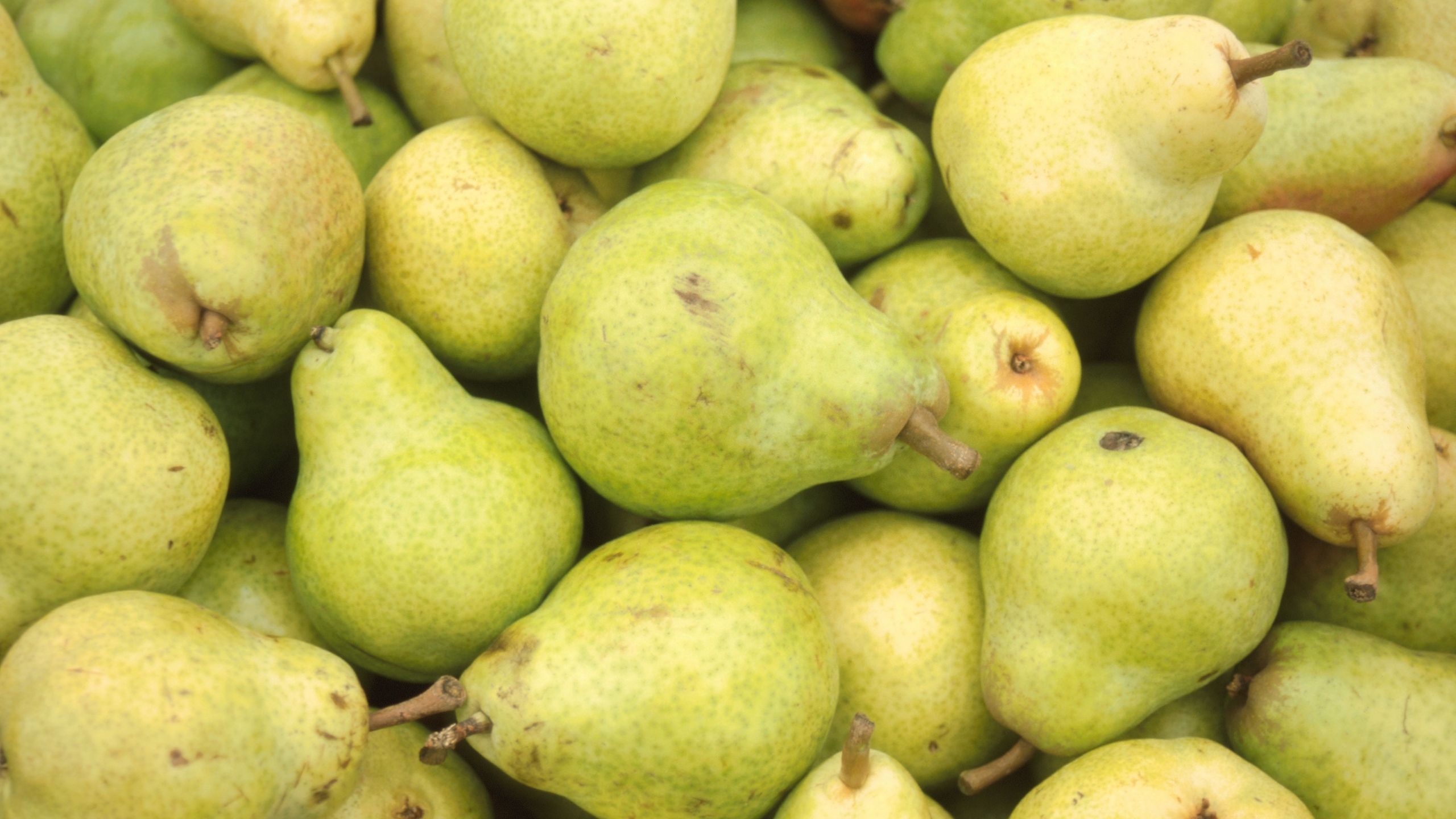Fruit Pests: Pear
The Backyard Orchardist
January 2020
Marion Murray, Extension IPM Specialist • Diane Alston, Extension Entomologist (No longer at USU)
DISEASES
(Listed in Order of Importance)
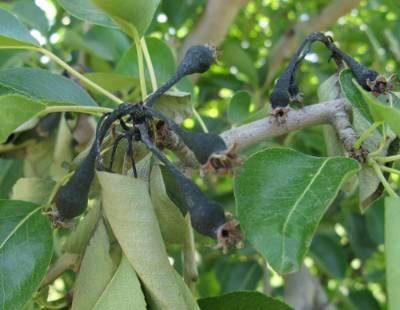
Fire Blight
Importance as a Pest on Pear: high
Other Fruit Hosts: apple and crabapple
General Info: Fire blight is caused by a bacterium called Erwinia amylovora. Pears are very susceptible to fire blight. Blossoms, terminal twigs, and sometimes entire limbs or trees are killed. Environmental conditions favoring infection are warm, rainy days during bloom. Rain, heavy dew, and insects spread oozing bacteria to flowers, where new infections occur.
Symptoms:
- infected blossoms and shoots turn black (shown at right).
- leaves on dead shoots remain attached.
- the bacterium overwinters in sunken cankers in the wood, which begin to ooze in spring when temperatures warm.
- infected twigs wilt over at the tip, in the shape of a shepherd’s crook.
Management: Most importantly, all infected shoots, twigs, and limbs should be pruned out of the tree as soon as they appear (about 2 weeks after bloom). Cut 12 inches below visible symptoms into healthy wood to be certain that the bacteria are removed. Do not prune during wet conditions, as this can contribute to disease spread. During bloom, protect flowers from infection by applying an antibiotic spray just before, or 24 hours after, a rainfall. Mix the labeled rates of streptomycin and oxytetracycline to prevent resistance.
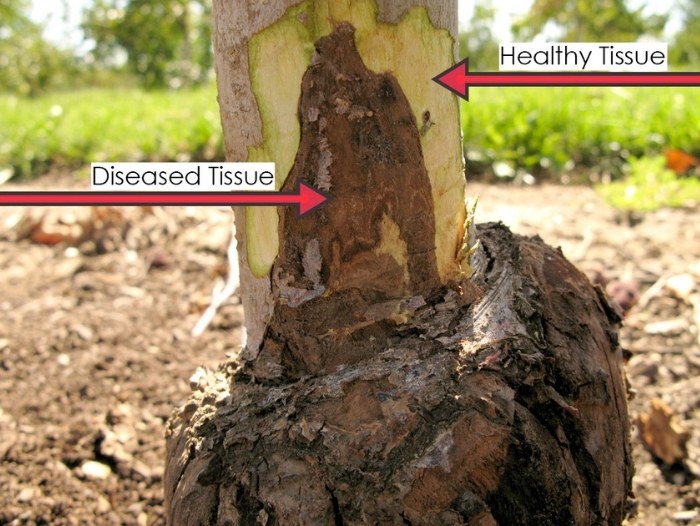
Crown Rot and Root Rot
Importance as a Pest on Pear: low-moderate
Other Fruit Hosts: all fruit trees
General Info: Crown rot and root rot is caused by a soil-borne, fungus-like organism (Phytophthora). This pathogen is present in most soils, but only causes infection when soils are saturated with water and a host tree is present. The pathogen quickly grows in the cambium, girdling the tree. Once trees are infected, there is no cure.
Symptoms:
- slow growth
- sparse, yellowing foliage
- small fruit
- wilting in hot weather
- sudden plant death
- Can be confirmed by using a knife to expose the inner bark of the root collar. Look for distinctive brown tissue (infected) in contrast to cream-colored tissue (healthy).
Management: Select sites with good water drainage for planting. Prevent standing water by cultivating the soil, not over irrigating, and/or adding mulch. Do not replant fruit trees in areas where root and/or crown rot occurred previously. Protect trees adjacent to infected trees by spraying foliage with phosphorus acid (Agri-fos, other) because phytophthora can spread by root-to-root contact.
INSECTS
(Listed in Order of Importance)

Codling Moth
Importance as a Pest on Pear: moderate to high
Other Fruit Hosts: apple, crabapple, and quince
General Info: Codling moths are the adults of the common “worms” that infest apples and pears. These moths emerge from overwintering sites in spring and lay their eggs on and near developing fruits. Larvae bore into the fruit to feed on the flesh and seeds. There are 2 - 3 generations per yr.
Symptoms:
- frass (sawdust-like excrement) on the outside of the fruit
- small holes in fruit and white larva may be inside fruit
- rot sometimes accompanies entry holes on fruit
Management: The key to successful management by the backyard orchardist is a combination of cultural practices and accurately timed insecticide sprays. Cultural practices include fruit thinning, removing infested fruits, and bagging fruit. Codling moth activity depends on the seasonal temperature, and the time to start sprays varies from year to year. To find out when codling moth is active in your area of the state and for spray recommendations, contact your local county Extension agriculture agent and subscribe to the USU IPM Tree Fruit Advisory. Conventional insecticides include carbaryl, malathion, zeta-cypermethrin, and gamma-cyhalothrin, while spinosad is an organic option.
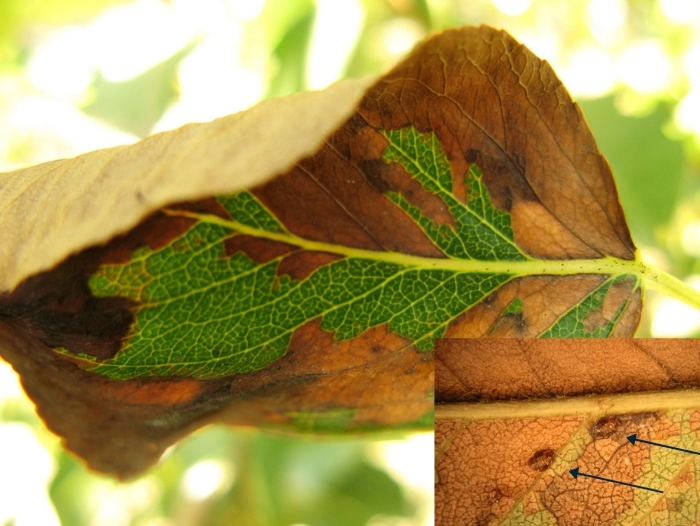
Pear Psylla
Importance as a Pest on Pear: moderate to high
Other Fruit Hosts: none
General Info: Pear psylla adults overwinter outside the orchard as adults and fly to pear trees in the early spring to lay eggs on buds and twigs. Nymphs hatch in spring and as they feed on leaves and fruit they secrete copious honeydew. Pear psylla may also transmit a disease called “pear decline” that can slowly kill trees over a number of years.
Symptoms:
- sticky honeydew on leaves and fruit, and sometimes black sooty mold
- random, scorched appearance to leaves
- leaf drop and decreased fruit yields
Management: The best control is achieved with a dormant oil spray before leaves emerge in spring, to kill newly laid eggs. If the psylla population is high during the growing season, use either a 1% oil spray, insecticidal soap, or spinosad (all are organic).

Pear-Leaf Blister Mite
Importance as a Pest on Pear: moderate
Other Fruit Hosts: ornamental pears
General Info: Pear-leaf blister mites are microscopic mites. They burrow under the lower surface of leaves and live inside small blisters all summer. Adults overwinter under leaf bud scales and emerge with new leaf growth in the spring. Low populations can be tolerated.
Symptoms:
- “blisters” that start green in spring and by mid-summer become brown (shown at right)
Management: Apply a treatment in early fall, before leaf drop, when mites are migrating from leaves to buds. Options include carbaryl, horticultural oil, or sulfur.
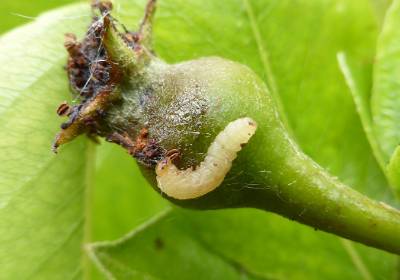
Pear Fruit Sawfly
Importance as a Pest on Pear: moderate
Other Fruit Hosts: none
General Info: Larvae of the pear fruit sawfly feed within fruitlets for six weeks starting in early to mid-spring. Adults are a reddish-yellow fly-like wasp that emerge from soil during pear pre-bloom. Females lay a single egg inside multiple flowers. The hatched larva then feeds on the flesh and seed of the developing pear fruitlet. When mature, larvae drop to the ground and burrow into the soil where they remain until spring. This pest is active several weeks before codling moth.
Symptoms:
- premature fruit drop
- fruit is deformed and swollen
- fruit skin is blemished
- round hole located near the calyx, accompanied by black decay and wet frass
Management: Tilling or cultivating the soil in the fall between trees can expose larvae to predators and cold temperatures. Conventional insecticides are best applied during the adult stage at either pre-bloom or petal fall, and options include horticultural oil (2% rate) mixed with carbaryl or a pyrethroid. For organic control, use oil alone at the pre-bloom stage.
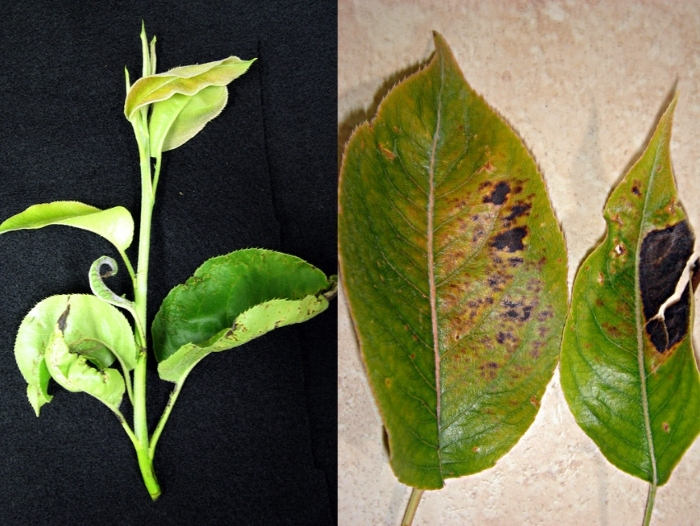
Spider Mites
Importance as a Pest on Pear: moderate
Other Fruit Hosts: all fruits
General Info: Mites are very small arthropods that are more closely related to ticks than insects. Spider mites overwinter as adults at the base of trees, or in ground cover, and may become a problem during hot, dry conditions in mid and late summer when they reproduce rapidly. As they feed, they remove sap and chlorophyll from leaves. Pears cannot tolerate high mite populations and symptoms are different from those on other trees.
Symptoms:
- blackened areas on leaves (including midrib, petiole, and/or shoot; shown at far right); blackened areas may show up after control has been implemented, especially if hot weather follows.
- severe feeding can cause deformity of new foliage (shown at near right)
- fine silk webbing that becomes apparent when populations are high
Management: Predatory mites that feed on spider mites can provide effective biological control if they aren’t harmed by pesticides. Low populations of spider mites can be ignored and are often kept in check by the predatory mites. Spider mite outbreaks often follow pesticide applications that upset the predator-prey balance. If needed, mites can be managed by washing down trees or plants with a stiff spray of water, and/or applying insecticidal soap or 1% horticultural oil (both are organic). Avoid applying soaps or oils during the hot part of the day as some leaf burn may result.





